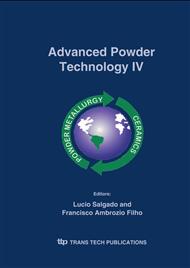[1]
Brandt, G, Ceramic cutting tools, state of the art and development trends. Materials Technology 14 (1) (1999) 17-24.
Google Scholar
[2]
Toulinson,W. J, Molyneux, I. D, Corrosion erosion and the flexural strength of WC-Co hardmetals. J. Mater. Sci., 26, (1991)1605-1608.
DOI: 10.1007/bf00544670
Google Scholar
[3]
Bhaumik, S. K, Balasubramaniam, R., Upadhyaya, G.S. and Vaidya, M.L., Oxidation behaviour of hard and binder phase modified WC- 10Co cemented carbides., J. Mater. Sci. Lett., 11, 1457 - 59 (1992).
DOI: 10.1007/bf00729663
Google Scholar
[4]
Acchar, W, Gomes,U. U, Kaysser, W and Goring, J, Strength degradation of tungsten carbidecobalt composite at elevated temperatures. Mater. Charac., 43, (1999), 27-32.
DOI: 10.1016/s1044-5803(98)00056-4
Google Scholar
[5]
Leiderman, M. Botstein, O. and Rosen, A., The Influence of Raw Materials on the final Properties of WC Cutting Tools., Proceeding of the 4th European Conference on Advanced Materials and Process, Italy, september (1995).
Google Scholar
[6]
Schubert, W, Bock, A and Lux, B, General Aspects and Limits of Conventional Ultrafine WC powder manufacture and hard metal production, Int.J. of. Refractory Metals&Hard materials, 13 (1995), 281-296.
DOI: 10.1016/0263-4368(95)92674-9
Google Scholar
[7]
Yuntian T. Zhu and Arumugam Manthiram, A new route for the synthesis of tungsten carbide cobalt nanocomposites. J. Am. Ceram. Soc., 77, (1994), 2777-78.
Google Scholar
[8]
Bhaumik, S. K, Balasubramaniam, R., Upadhyaya, G.S. and Vaidya, M.L., Oxidation behaviour of hard and binder phase modified WC-10Co cemented carbides., J. Mater. Sci. Lett., 11, 1457 - 59 (1992).
DOI: 10.1007/bf00729663
Google Scholar
[9]
Bhaumik, S.K., Upadhyaya, G.S. and Vaidya, M.L., Properties and microstructure of WC-TiCCo and WC-TiC-Mo2C-Co(Ni) cemented carbides., Mater. Sci. Technology, 7, 723 - 27 (1991).
DOI: 10.1179/mst.1991.7.8.723
Google Scholar
[10]
Bhaumik, S.K., Upadhyaya, G.S. and Vaidya, L.M., SEM Study of the Fracture Behavior of Some WC Based Cemented Carbides. Pract. Met., 28, 238 - 249 (1991).
DOI: 10.1515/pm-1991-280507
Google Scholar
[11]
Dernovsek, O, Bressiani,J. C, Bressiani A.H. A Acchar, W and Greil, P, Reaction bonded niobium carbide-alumina composite ceramics from polymer-filler mixtures. J. Mater. Science, 35, (2000), 2201-07.
DOI: 10.1023/a:1004766607619
Google Scholar
[12]
Acchar, W, Greil, P, Martinelli,A. E, Cairo, C.A. A, Bressiani A.H. and Bressiani,J. C, Sintering behaviour of alumina - niobium carbide composites. J. Europ. Ceram. Soc., 20, (2000), 1765-69.
DOI: 10.1016/s0955-2219(00)00060-1
Google Scholar
[13]
Pasotti, M.R. R, Bressiani A.H. A, and Bressiani,J. C, Sintering of alumina-niobium carbide composite International Journal of Refractory Metals & Hard Materials 16 (1998) 423-427.
DOI: 10.1016/s0263-4368(98)00053-5
Google Scholar
[14]
Bolton,J. D and Gant, A. J, Fracture in ceramic-reinforced metal matrix composites based on high-speed steel., J. mater. Science, 33 (1998), 939-953.
Google Scholar
[15]
Shetty, D.K., Wrigth, I.G., Mincer, P. N and Clauer, A.H. Indentation fracture of WC-Co cemets.J. Mater. Sci., 20, 1873 (1985).
DOI: 10.1007/bf00555296
Google Scholar
[16]
Han, D. and Mecholsky, J.J., Fracture analysis of cobalt-bonded tungsten carbide composites. J. Mater. Sci., 25, 4949 - 56 (1990).
DOI: 10.1007/bf00580112
Google Scholar
[17]
Acchar, W., Martinelli,A. E, Vieira,F. A and Cairo, C. A, Mater. Science & Eng A284 (2000) 84-87.
Google Scholar


